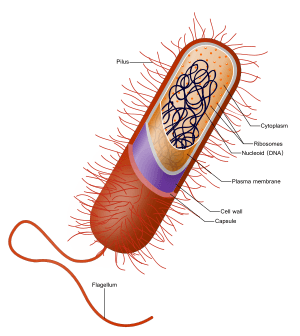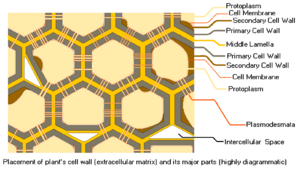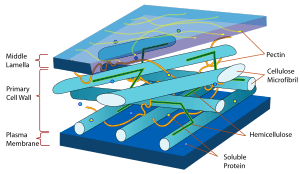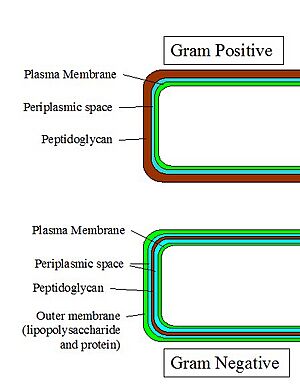Cell wall facts for kids
A cell wall is a strong, protective layer found around the cells of plants, bacteria, fungi, algae, and some archaea. Think of it like a sturdy outer shell for a cell! Animal cells, including human cells, do not have cell walls.
The cell wall is located outside the cell membrane. Its main jobs are to give the cell support and protection, help it keep its shape, and control how the cell and plant grow. It also acts like a filter, letting some things in and keeping others out. Plus, it's like a pressure vessel, stopping the cell from bursting if too much water enters it.
The material that makes up a cell wall can be different depending on the organism. For example, in plants and algae, cell walls are mostly made of long molecules called cellulose, along with pectin and hemicellulose. The cell wall has tiny channels that allow water and small molecules to pass through.
Contents
History of Discovery
The plant cell wall was first seen and named "a wall" by Robert Hooke in 1665. For a long time, scientists didn't pay much attention to it, thinking of it mostly as a material for industrial uses.
In 1804, Karl Rudolphi and J.H.F. Link showed that cells have their own separate walls. Before this, people thought cells shared walls and that fluids moved between them that way.
In 1930, Ernst Münch came up with the term apoplast. This term helped separate the "living" parts of a plant cell from the "dead" parts, which included the cell wall.
What Cell Walls Do
Strength and Support
The cell wall provides mechanical strength and helps cells keep their shape. This is its most important job. Imagine a balloon inflated inside a strong wicker basket. The basket (cell wall) makes the balloon (cell) very rigid and hard to damage. This is how organisms with cell walls get their strength.
Even though plant cell walls are strong, they can also be flexible. You can see this when plants wilt; their stems and leaves droop because the cell walls lose some of their stiffness.
Some plants make their cell walls even stronger by adding extra layers. A secondary cell wall is an added layer of cellulose that makes the wall more rigid. Other materials like lignin (found in xylem cells, which transport water) or suberin (found in cork cells) can be added. These compounds are very stiff and waterproof. This is why wood and bark cells in trees are so strong.
Permeability
Small molecules, including tiny proteins, can easily pass through the primary plant cell wall. This allows important substances like water and carbon dioxide to move throughout the plant. The pH (how acidic or basic something is) also plays a role in how molecules move through cell walls.
Plant Cell Walls
Plant cell walls need to be strong enough to handle the internal pressure from water entering the cell. This pressure can be several times stronger than the air pressure around us! Plant cell walls can range from very thin to several micrometers thick.
Layers of Plant Cell Walls
Plant cell walls can have up to three main layers:
- The primary cell wall is usually thin, flexible, and can stretch. It forms while the cell is growing.
- The secondary cell wall is a thick layer that forms inside the primary cell wall after the cell has finished growing. Not all cell types have a secondary wall. For example, cells that transport water in plants (like in xylem) have a secondary wall with lignin, which makes it strong and waterproof.
- The middle lamella is the outermost layer, rich in pectins. It acts like a glue, holding adjacent plant cells together.
What Plant Cell Walls are Made Of
In a growing plant cell's primary wall, the main materials are cellulose, hemicellulose, and pectin. Cellulose forms tiny fibers called microfibrils, which are linked together by hemicellulose. This network is then held within a matrix of pectin.
The secondary cell walls contain more compounds that change their strength and how easily things can pass through them. The main materials in wood (which is mostly secondary cell walls) include:
- cellulose, about 35-50%
- xylan, about 20-35% (a type of hemicellulose)
- lignin, about 10-25% (a complex material that fills the spaces in the wall, making it strong and waterproof)
Plant cell walls also contain a small amount of proteins and many enzymes. These enzymes help build, trim, and connect the different parts of the wall. Some plant cell walls, especially in grasses, can even contain tiny silica crystals, which make them stronger and protect them from animals that eat plants.
Cell walls in some plant tissues can also store carbohydrates. These can be broken down later to provide energy for the plant's growth. For example, the cell walls in the seeds of cereal grasses store sugars that feed the growing plant embryo when the seed sprouts.
How Plant Cell Walls Form
The middle lamella is formed first, acting as a "cell plate" during cell division. Then, the primary cell wall is built inside the middle lamella. The primary cell wall is made of cellulose microfibrils that are arranged in all directions. These microfibrils are produced at the cell's outer membrane and are held together by strong bonds, giving the wall high tensile strength. Plant cells are connected to each other and share a jelly-like membrane (the middle lamella) that contains magnesium and calcium salts. Cells can also communicate through tiny channels called plasmodesmata, which connect the living parts of neighboring cells through the cell wall.
In some plants, once a cell reaches its full size, a secondary wall is built between the cell's outer membrane and the primary wall. Unlike the primary wall, the cellulose microfibrils in the secondary wall are arranged in parallel layers, making the structure very rigid. Cells with secondary cell walls can be very hard, like the gritty cells in a pear or quince fruit. Communication between cells with secondary walls happens through small openings called pits, which allow plasmodesmata to connect them.
Fungal Cell Walls

Many organisms were once grouped as "fungi," but some have been moved to different groups because their cell walls are very different. Most true fungi have cell walls made mainly of chitin and other polysaccharides. Unlike plants, true fungi do not have cellulose in their cell walls.
In fungi, the cell wall is the outermost layer, surrounding the plasma membrane. It's made of three main parts:
- chitin: Long chains of a sugar molecule, similar to what makes up the exoskeletons of insects.
- glucans: Glucose polymers that help link the chitin chains together, giving the cell wall its stiffness.
- proteins: These include enzymes needed to build and break down the cell wall, as well as structural proteins.
Other Eukaryotic Cell Walls
Algae
Like plants, algae have cell walls. Algal cell walls can contain polysaccharides like cellulose, or various glycoproteins, or both. The specific types of polysaccharides in algal cell walls are often used to help classify different types of algae.
Some common materials in algal cell walls include:
- Mannans: Found in some marine green algae and red algae.
- Xylans: Another type of polysaccharide.
- Alginic acid: Common in the cell walls of brown algae.
- Sulfonated polysaccharides: Found in most algae, especially red algae, like agarose and carrageenan.
A special group of algae called diatoms build their cell walls (called frustules) from silicon dioxide (silica), which is basically glass! These silica walls require less energy to build compared to organic cell walls, which might explain why diatoms can grow so quickly.
Water Molds
The group called Oomycetes, also known as water molds, are plant pathogens that act like fungi. For a long time, people thought they were fungi, but scientists now know they are different. Unlike fungi, oomycetes usually have cell walls made of cellulose and glucans, not chitin. Their cell walls also contain the amino acid hydroxyproline, which is not found in fungal cell walls.
Slime Molds
Slime molds are another group that was once classified as fungi. They are single-celled organisms that can come together to form a reproductive stalk. The cells in this stalk and the spores they produce have a cellulose wall.
Prokaryotic Cell Walls
Bacterial Cell Walls

Outside the cell membrane of bacteria is the bacterial cell wall. Bacterial cell walls are made of a unique material called peptidoglycan (also known as murein). This is different from the cellulose in plant cell walls or the chitin in fungal cell walls. The cell wall is vital for many bacteria to survive.
There are two main types of bacterial cell walls, known as gram-positive and gram-negative. These names come from how the cells react to a special test called the Gram stain, which helps classify bacteria.
Gram-positive bacteria have a thick cell wall with many layers of peptidoglycan. Gram-negative bacteria have a thinner cell wall with only a few layers of peptidoglycan, surrounded by an extra outer membrane.
These differences in cell wall structure affect how antibiotics work. For example, some antibiotics like penicillin kill bacteria by stopping the peptidoglycan from linking together, which weakens the cell wall and causes the cell to burst.
Archaeal Cell Walls
Archaea are another group of single-celled organisms, similar to bacteria but distinct from them. Their cell walls are unusual because they never contain peptidoglycan, which is found in all bacterial cell walls.
Some archaea have a cell wall made of something similar called pseudopeptidoglycan. While it looks like bacterial peptidoglycan, it has important chemical differences. For example, it uses a different sugar and different types of amino acids in its structure.
Other types of archaeal cell walls include:
- A thick layer of polysaccharides, found in some archaea like Methanosarcina.
- Cell walls made of glycoproteins, found in some archaea that live in extreme environments, like very hot places or very salty places. For example, Halobacterium thrives in high salt because its cell wall needs a lot of positive sodium ions to stay stable.
- Some archaea have cell walls made only of surface-layer proteins, called S-layers. These S-layers are also common in bacteria.
See also
In Spanish: Pared celular para niños






